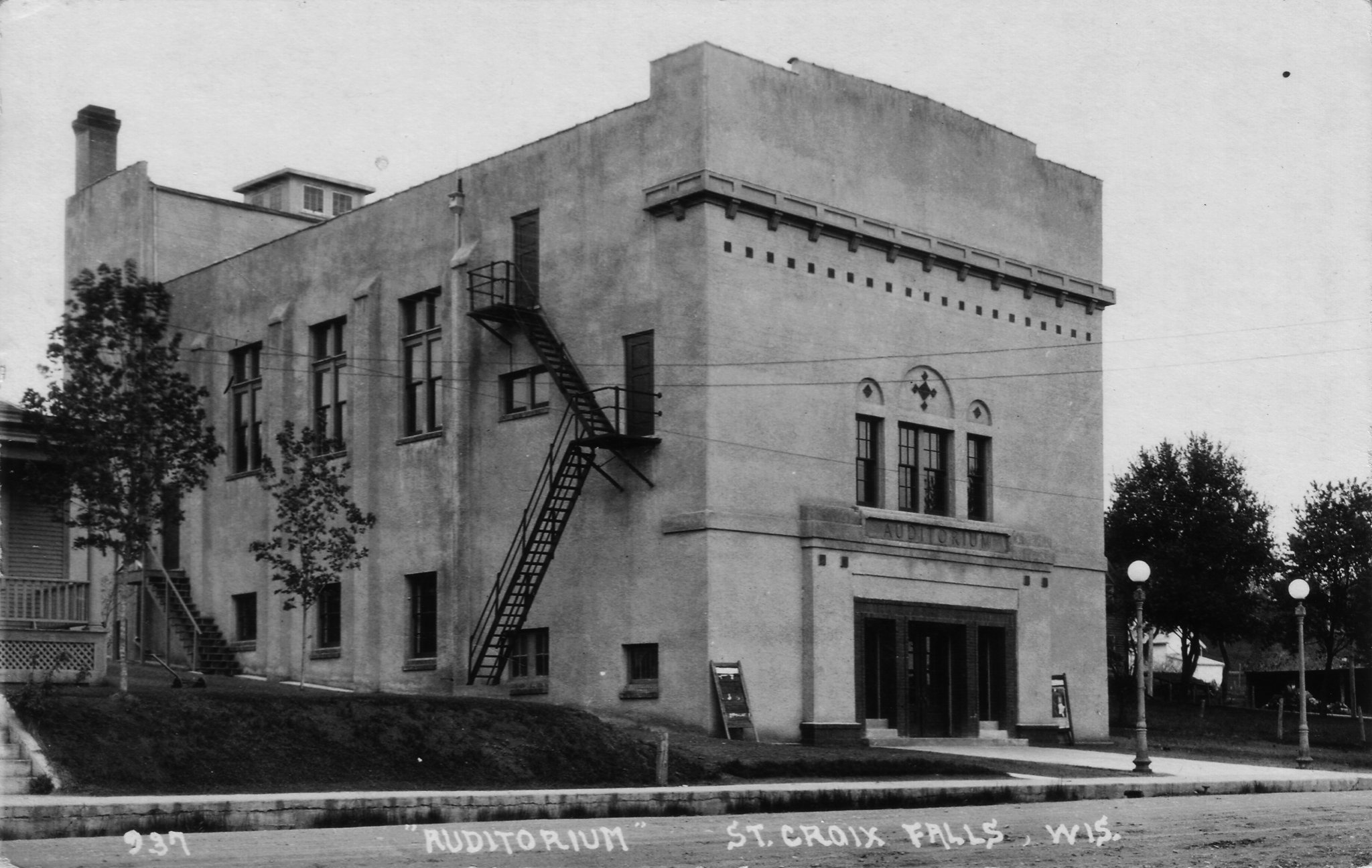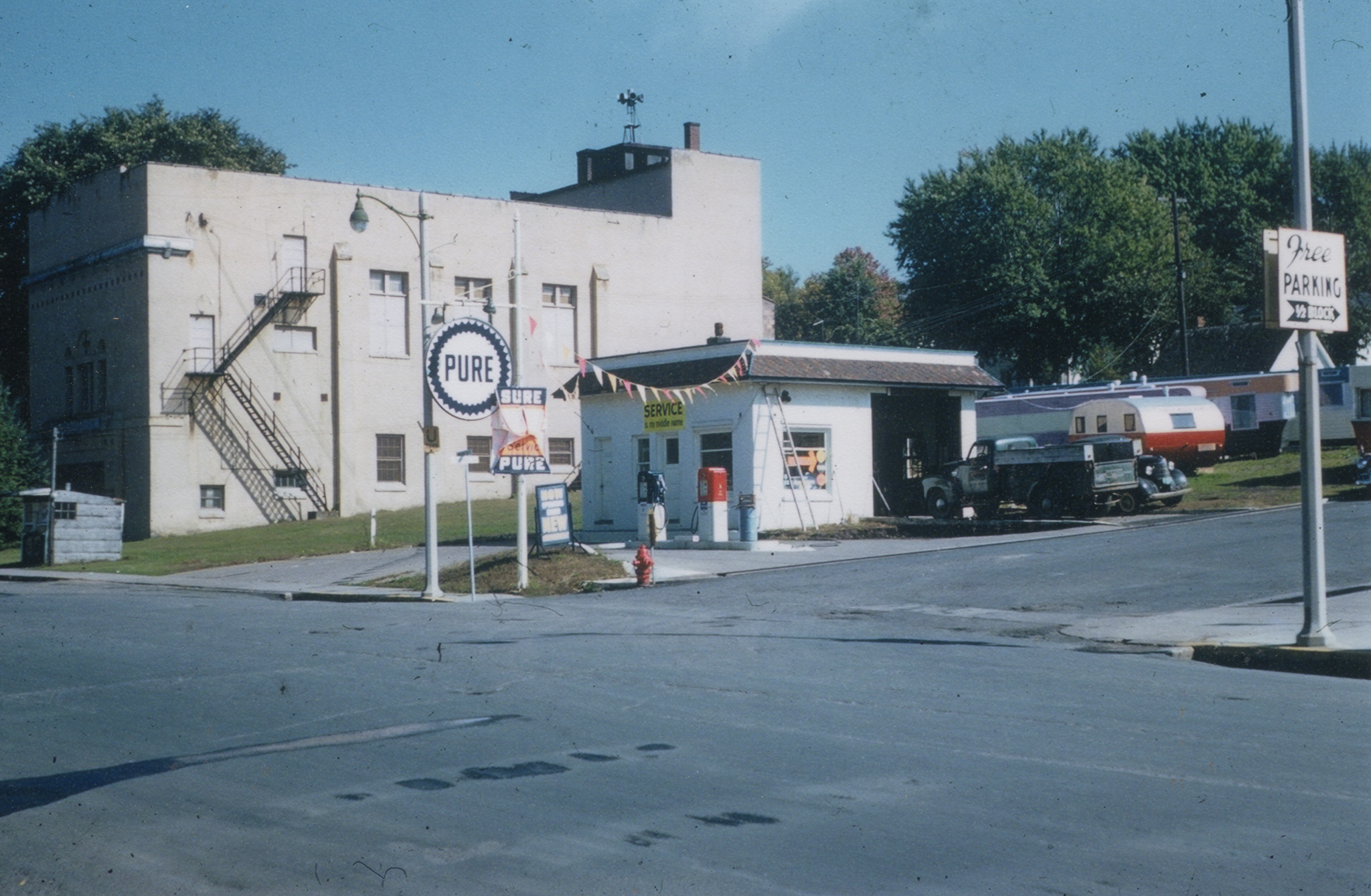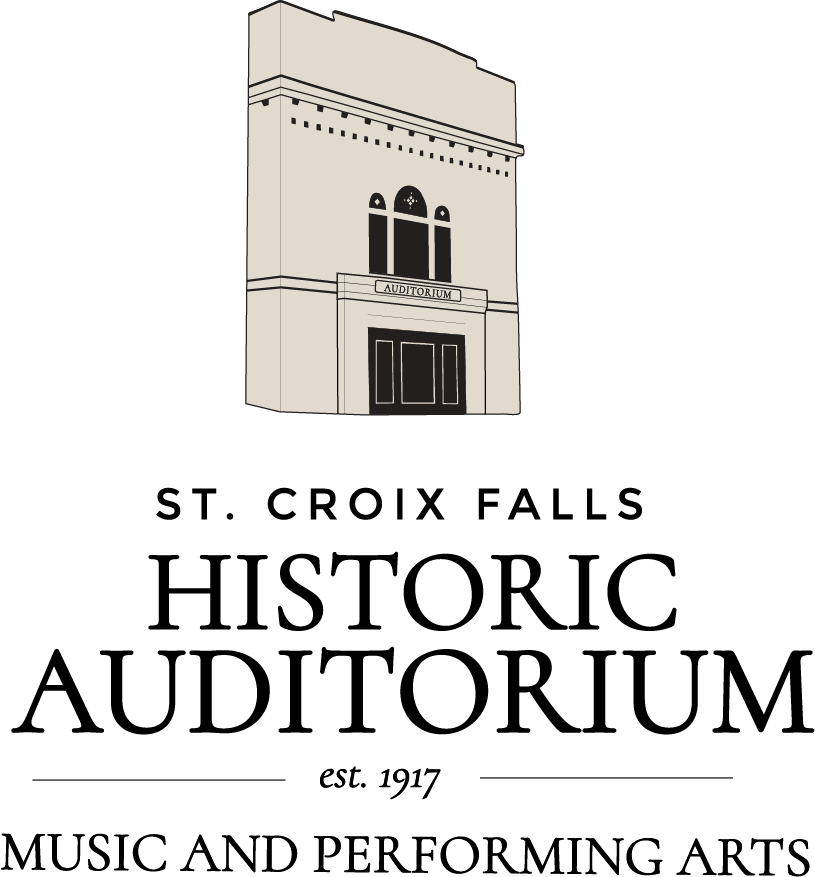



The Historic Auditorium
In the late 1800’s St. Croix Falls was undeniably a bustling river town. In fact, when the village was incorporated in 1888 a village hall was built on the 200 block of North Adams Street. The hall served as both a municipal government and social center of the community for many years and was utilized evenings and weekends for dances, concerts, commencement exercises, and gatherings of all kinds.
As St. Croix Falls continued to grow citizens interested in cultural endeavors made a case for the construction of a municipal auditorium. Not long after the Standard Press ran a front-page notice of a “mass meeting to ascertain public sentiment in regard to building an Auditorium . . . to cost not less than $15,000,” the St. Croix Falls Village Board contracted architects from St. Paul to design the proposed structure. The citizen’s dream of an Auditorium was finally coming to fruition and on October 22, 1915 the general contractor John F. Lindhart of Frederic was awarded the contract for the sum of $11,170. Swanson Brothers of St. Paul was awarded the heating contract at $1,314, and P.J. Aune of Milltown was awarded the plumbing contract for the sum of $365.
In May1916, the Village Board met with both the architects and
general contractor to discuss and approve revisions to the plan which would cost an additional $5,400. Construction continued through most of 1916 and in January 1917, while World War I raged overseas, citizens of St. Croix Falls gathered to watch one of the top silent films of the era, The Battle Cry of Peace, in their new Auditorium.
The vision by early residents of St. Croix Falls for the Auditorium was twofold. The 45’ by 95’ multi-level building had been planned to house a civic community center on the street level and upstairs, where they placed the stage, touring vaudeville shows and opera companies would perform. Unfortunately, live theatre would be decades in coming for the residents of this scenic river town for it seemed that St. Croix Falls was too far from the Twin Cities and its population too small for touring groups to anticipate financial success. Furthermore, World War I and the Spanish Flu undoubtedly made it difficult to promote public gatherings that relied on disposable income for entertainment.
When it became clear that touring theatrical and opera companies were difficult to book into the upstairs portion of the Auditorium, the city contracted R.O. Pepper to relocate his movie business, Bide-A-Wee Motion Picture Theater, from the original village hall on Adams Street to the palatial Auditorium on North Washington. Built to seat over 400 on the main floor and surely another 100 or more in the balcony, the performance space of the Auditorium included a proscenium arch stage complete with a fly tower for easily moving back drops into place. When the movies came in, the original scenic opera drop (which doubled as a fire curtain) was flown up into the tower and forgotten. Painted in 1916 by Twin City Scenic Studio of Minneapolis, the drop was discovered in the summer of 1989 as the Friends of the Auditorium Theatre prepared the building for use in producing live theatre. Patrons to the Festival Theatre frequently have the opportunity to view this tremendous historical find as it has been used as the back drop for most Music Series performances starting in 2002.
During the 1918 conversion to a movie house, the Auditorium’s balcony had to be altered to accommodate the new projection room. At the center of the lower half of the balcony, the original stepped floor was removed and the floor leveled. Due to potential fire hazards created by projection room technology of the era, the room was made non-combustible from the inside-out by adding a concrete floor finish on top of the existing wood floor and a skim coat of concrete finish to the walls and ceiling.
Silent films ruled the days until 1928 when the “talkies” came into play. During the silent film era, local musicians (generally pianists or organists) were employed to provide live background music six days a week – but never on Sundays. Then, quite a stir occurred in the early 30’s when General Electric came to town with sound experts in tow. It was at that time that acoustical tiles were suspended from the original ceiling and added to the walls.
As a civic community center, the Auditorium featured a street level kitchen and gymnasium to accommodate dances, holiday programs, sports activities, piano recitals, high school commencement exercises, and even political events such as a 1936 dinner preceding a speech by U.S. Presidential candidate Norman Thomas (Socialist Party), whose running mate was Polk County Legislator, George A. Nelson (Milltown). Spectators could watch their town team play basketball from the area called the Mezzanine which opened to the east overlooking the gymnasium. In her wonderful history, St. Croix Tales and Trails, Rosemarie Vezina Braatz reports that the gymnasium “was pressed into use by volunteers rolling bandages for the Red Cross during World War I, and for rallies to support the war effort . . . in 1918, it became a hospital during the influenza pandemic that wracked the world.”
In time, newly constructed public schools would provide space for ballgames and such, freeing up the street level of the Auditorium. The space did not stay dormant for long as it was leased to a variety of sewing factories. In the early 1970’s the street level of the multi-faceted building was remodeled yet again and the library and city offices called it home. Since 1994, when the new city hall was built, the library has occupied most of the first floor of the Auditorium, with Festival Theatre utilizing the very front for their central box office and public restrooms.
In the spring of 1961 the St. Croix City Council contracted for the design and construction of a new entrance to the Auditorium, resulting in a twenty-two foot addition stretching to the sidewalk on the west side of the building. In order to accommodate the new entrance, the original central double doors and single doors on either side, along with ornamental brickwork, were removed. Also removed were the original check room, women’s room, ticket windows, and the first set of stairs with landings.
When the movie theatre moved next door in 1985, the upstairs theater space went unused until The Friends of the Auditorium Theatre were issued a lease in 1989 by the city and then leveraged thousands of hours of volunteer work as well as thousands of dollars to begin the process of cleaning and redecorating the building. In 1990, Festival Theatre, an equity company, began producing theatre in the space originally created for that purpose. The residents of St. Croix Falls and surrounding communities now had the opportunity that the citizens of long ago only dreamed of. Today there are patrons of Festival Theatre who are children, grand-children and even great-grandchildren of the very same insightful citizens who first began this long journey of bringing live entertainment to the valley.
With history as its guide, Festival Theatre worked closely with the city to continue renovations, including major structural and mechanical efforts such as replacing the roof, dealing with electrical and air conditioning issues, and the dramatic removal of the 1961 lobby addition. In October 2006 the building was named to the Wisconsin Register of Historic Places; and in January 2007, the 90th anniversary of first opening to the public, the Auditorium was named to the National Register of Historic Places. In May 2007 the City of St. Croix Falls committed funds to complete a master plan for rehabilitating the historic structure for all aspects of renovation and future building operations, and was completed by December 2007. The theater company continued its performances in the structure while the city continued to wrestle with their future plans for the auditorium. The renovation plans remained on hold while various city committees continued to look for best options and fundraise.
In 2014, the city amended the Tax Increment District they had in place at that time to add the auditorium renovation project into its scope. Once those funds were added to the project budget, things started to take off in planning. The city still had to get past the issue of public vs. private ownership of the building before any further movement continued with the project. Unfortunately, the building fell into such disrepair that the theater company had to vacate, and the auditorium sat empty for several years. In 2021 the city council voted in favor of private ownership of the building relinquishing its105 years of ownership of the Civic Auditorium.
At long last, the structure was sold to 210 Civic, LLC and the transaction closed in March of 2023. Construction plans were set in place to accommodate the budget monies from all sources and the actual construction of new additions to the building, as well as renovation to the original footprint structure began in earnest.
Opening of the completely new renovation of The Historic Auditorium will occur in late spring of 2024!
Information gathered from St. Croix Tales and Trails by Rosemarie Vezina Braatz, the Historic Structures Report of the Historic Auditorium Theatre prepared by F.J. Sabongi, Historic Structures Specialist, and dozens of conversations with community members and provided with courtesy from the Festival Theatre website and updated by Jeff Virchow.
